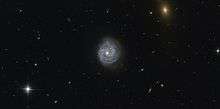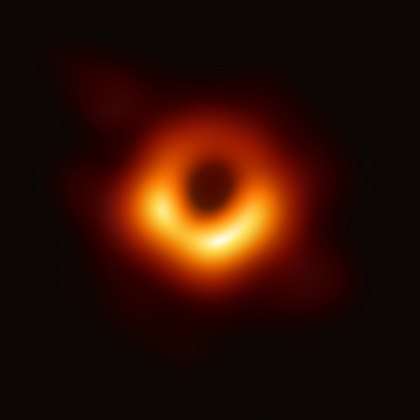Intermediate-mass black hole
An intermediate-mass black hole (IMBH) is a class of black hole with mass in the range 102-105 solar masses: significantly more than stellar black holes but less than the 105-109 solar mass supermassive black holes.[2][3] Several IMBH candidate objects have been discovered in our galaxy and others nearby, based on indirect gas cloud velocity and accretion disk spectra observations of various evidentiary strength.
.jpg)
Observational evidence
The strongest evidence for IMBHs comes from a few low-luminosity active galactic nuclei.[4] Due to their activity, these galaxies almost certainly contain accreting black holes, and in some cases the black hole masses can be estimated using the technique of reverberation mapping. For instance, the spiral galaxy NGC 4395 at a distance of about 4 Mpc appears to contain a black hole with mass of about 3.6×105 solar masses.[5]
The largest up-to-date sample of intermediate-mass black holes includes 305 candidates[6] selected by sophisticated analysis of one million optical spectra of galaxies collected by the Sloan Digital Sky Survey.[7] X-ray emission was detected from 10 of these candidates[6] confirming their classification as IMBH.
Some ultra-luminous X ray sources (ULXs) in nearby galaxies are suspected to be IMBHs, with masses of a hundred to a thousand solar masses.[8] The ULXs are observed in star-forming regions (e.g., in starburst galaxy M82[9]), and are seemingly associated with young star clusters which are also observed in these regions. However, only a dynamical mass measurement from the analysis of the optical spectrum of the companion star can unveil the presence of an IMBH as the compact accretor of the ULX.
A few globular clusters have been claimed to contain IMBHs, based on measurements of the velocities of stars near their centers; the figure shows one candidate object. However none of the claimed detections has stood up to scrutiny.[4] For instance, the data for M31 G1, the object shown in the figure, can be fit equally well without a massive central object.[10]
Additional evidence for the existence of IMBHs can be obtained from observation of gravitational radiation, emitted from a binary containing an IMBH and a compact remnant or another IMBH.[11][12]
Finally, the M-sigma relation predicts the existence of black holes with masses of 104 to 106 solar masses in low-luminosity galaxies.
Potential discoveries

In November 2004 a team of astronomers reported the discovery of GCIRS 13E, the first intermediate-mass black hole in our galaxy, orbiting three light-years from Sagittarius A*.[14] This medium black hole of 1,300 solar masses is within a cluster of seven stars, possibly the remnant of a massive star cluster that has been stripped down by the Galactic Center. This observation may add support to the idea that supermassive black holes grow by absorbing nearby smaller black holes and stars. However, in 2005, a German research group claimed that the presence of an IMBH near the galactic center is doubtful, based on a dynamical study of the star cluster in which the IMBH was said to reside.[15] An IMBH near the galactic center could also be detected via its perturbations on stars orbiting around the supermassive black hole.[16]
In January 2006 a team led by Philip Kaaret of the University of Iowa announced the discovery of a quasiperiodic oscillation from an intermediate-mass black hole candidate located using NASA's Rossi X-ray Timing Explorer. The candidate, M82 X-1, is orbited by a red giant star that is shedding its atmosphere into the black hole.[17] Neither the existence of the oscillation nor its interpretation as the orbital period of the system are fully accepted by the rest of the scientific community, as the periodicity claimed is based on only about four cycles, meaning that it is possible for this to be random variation. If the period is real, it could be either the orbital period, as suggested, or a super-orbital period in the accretion disk, as is seen in many other systems.
In 2009, a team of astronomers led by Sean Farrell discovered HLX-1, an intermediate-mass black hole with a smaller cluster of stars around it,[18] in the galaxy ESO 243-49. This evidence suggested that ESO 243-49 had a galactic collision with HLX-1's galaxy and absorbed the majority of the smaller galaxy's matter.
A team at the CSIRO radio telescope in Australia announced on 9 July 2012 that it had discovered the first intermediate-mass black hole.[19]
In 2015 a team at Keio University in Japan found a gas cloud (CO-0.40-0.22) with very wide velocity dispersion.[20] They performed simulations and concluded that a model with a black hole of around one hundred thousand solar masses would be the best fit for the velocity distribution.[21] However, a later work pointed out some difficulties with the association of high-velocity dispersion clouds with intermediate mass black holes and proposed that such clouds might be generated by supernovae.[22] Radio observations with the Atacama Large Millimeter/submillimeter Array confirmed absence of an IMBH near CO-0.40-0.22 and found that the large velocity dispersion of the cloud is created by superposition of two molecular clouds with different line-of-sight velocities. The features identified as signatures of IMBH-cloud interaction in previous studies were confirmed to be artifacts created by erroneous data reduction.[23] Further theoretical studies of the gas cloud and nearby IMBH candidates have been inconclusive but have reopened the possibility,[24] though no observational evidence for existence of an IMBH has been reported after that.
In 2017, it was announced that a black hole of a few thousand solar masses may be located in the globular cluster 47 Tucanae. This was based on the accelerations and distributions of pulsars in the cluster;[25] however, later analysis of an updated and more complete data set on these pulsars finds no positive evidence for this.[26]
Observations in 2018 of several molecular gas streams orbiting around an invisible object near the galactic center, designated HCN-0.009-0.044, suggested that it is a black hole of thirty-two thousand solar masses and, if so, is the third IMBH discovered in the region.[27]
In 2020, astronomers reported the possible finding of an intermediate-mass black hole, named 3XMM J215022.4-055108, in the direction of the Aquarius constellation, about 740 million light years from Earth.[28][29]
Origin
Intermediate-mass black holes are too massive to be formed by the collapse of a single star, which is how stellar black holes are thought to form. Their environments lack the extreme conditions—i.e., high density and velocities observed at the centers of galaxies—which seemingly lead to the formation of supermassive black holes. There are three postulated formation scenarios for IMBHs. The first is the merging of stellar mass black holes and other compact objects by means of accretion. The second one is the runaway collision of massive stars in dense stellar clusters and the collapse of the collision product into an IMBH. The third is that they are primordial black holes formed in the Big Bang.[30]
References
- Gebhardt, Karl; Rich, R. M.; Ho, Luis C. (December 2005), "An Intermediate-Mass Black Hole in the Globular Cluster G1: Improved Significance from New Keck and Hubble Space Telescope Observations", The Astrophysical Journal, 634 (2): 1093–1102, arXiv:astro-ph/0508251, Bibcode:2005ApJ...634.1093G, doi:10.1086/497023
- Jiang, Yan-Fei; Greene, Jenny E.; Ho, Luis C.; Xiao, Ting; Barth, Aaron J. (2011), The Host Galaxies of Low-mass Black Holes
- Graham, Alister W.; Scott, Nicholas (2015), The (Black Hole)-bulge Mass Scaling Relation at Low Masses
- Merritt, David (2013). Dynamics and Evolution of Galactic Nuclei. Princeton, NJ: Princeton University Press. ISBN 9781400846122.
- Peterson, Bradley; et al. (2005). "Multiwavelength Monitoring of the Dwarf Seyfert 1 Galaxy NGC 4395. I. A Reverberation-based Measurement of the Black Hole Mass". The Astrophysical Journal. 632 (2): 799–808. arXiv:astro-ph/0506665. Bibcode:2005ApJ...632..799P. doi:10.1086/444494.
- Chilingarian, Igor; et al. (2018). "A Population of Bona Fide Intermediate-mass Black Holes Identified as Low-luminosity Active Galactic Nuclei". The Astrophysical Journal. 863 (1): 799–808. arXiv:1805.01467. Bibcode:2018ApJ...863....1C. doi:10.3847/1538-4357/aad184.
- Sloan Digital Sky Survey https://www.sdss.org
- Maccarone, T.J.; Kundu, A; Zepf, SE; Rhode, KL (2007). "A black hole in a globular cluster". Nature. 445 (7124): 183–185. arXiv:astro-ph/0701310. Bibcode:2007Natur.445..183M. doi:10.1038/nature05434. PMID 17203062.
- Patruno, A.; Portegies Zwart, S.; Dewi, J.; Hopman, C. (2006). "The ultraluminous X-ray source in M82: an intermediate-mass black hole with a giant companion". Monthly Notices of the Royal Astronomical Society: Letters. 370 (1): L6–L9. arXiv:astro-ph/0506275. Bibcode:2006MNRAS.370L...6P. doi:10.1111/j.1745-3933.2006.00176.x.
- Baumgardt, H.; et al. (2003). "A Dynamical Model for the Globular Cluster G1". The Astrophysical Journal. 589 (1): L25–L28. arXiv:astro-ph/0301469. Bibcode:2003ApJ...589L..25B. doi:10.1086/375802.
- Hopman, Clovis; Simon Portegies Zwart (2005). "Gravitational waves from remnants of ultraluminous X-ray sources". Mon. Not. R. Astron. Soc. Lett. 363 (1): L56–L60. arXiv:astro-ph/0506181. Bibcode:2005MNRAS.363L..56H. doi:10.1111/j.1745-3933.2005.00083.x.
- "Measuring Intermediate-Mass Black-Hole Binaries with Advanced Gravitational Wave Detectors". Gravitational Wave Group. University of Birmingham. Retrieved 28 November 2015.
- "A black hole of puzzling lightness". www.spacetelescope.org. Retrieved 9 January 2017.
- S2 and Central Black Hole
- Schoedel, R.; A. Eckart; C. Iserlohe; R. Genzel; T. Ott (2005). "A Black Hole in the Galactic Center Complex IRS 13E?". Astrophys. J. 625 (2): L111–L114. arXiv:astro-ph/0504474. Bibcode:2005ApJ...625L.111S. doi:10.1086/431307.
- Gualandris, A.; Merritt, D. (2009). "Perturbations of Intermediate-mass Black Holes on Stellar Orbits in the Galactic Center". Astrophys. J. 705 (1): 361–371. arXiv:0905.4514. Bibcode:2009ApJ...705..361G. doi:10.1088/0004-637X/705/1/361.
- Dying Star Reveals More Evidence for New Kind of Black Hole | Science Blog
- Soria, Roberto; Hau, George K. T.; Graham, Alister W.; Kong, Albert K. H.; Kuin, N. Paul M.; Li, I.-Hui; Liu, Ji-Feng; Wu, Kinwah (2010), Discovery of an optical counterpart to the hyperluminous X-ray source in ESO 243-49
- Nease, Eric (9 July 2012). "Astronomers spot the very first intermediate-mass black hole". The Bunsen Burner. Phillips Cronkite Media Group. Archived from the original on 13 July 2012. Retrieved 9 July 2012.
- Oka, Tomoharu; Mizuno, Reiko; Miura, Kodai; Takekawa, Shunya (December 28, 2015). "Signature of an Intermediate-Mass Black Hole in the Central Molecular Zone of Our Galaxy". Astrophysical Journal. 816 (1): L7. arXiv:1512.04661. Bibcode:2016ApJ...816L...7O. doi:10.3847/2041-8205/816/1/L7.
- "Signs of Second Largest Black Hole in the Milky Way - Possible Missing Link in Black Hole Evolution". National Astronomical Observatory of Japan. January 15, 2016.
- Yalinewich, Almog; Beniamini, Paz (2018), "Supernovae generated High Velocity Compact Clouds", Astronomy & Astrophysics, 612: L9, arXiv:1709.05738, Bibcode:2018A&A...612L...9Y, doi:10.1051/0004-6361/201732389
- Tanaka, Kunihiko (April 2018), "ALMA Images of the Host Cloud of the Intermediate-mass Black Hole Candidate CO-0.40-0.22* : No Evidence for Cloud-Black Hole Interaction, but Evidence for a Cloud-Cloud Collision", The Astrophysical Journal, 859 (2): 86, arXiv:1804.03661, Bibcode:2018ApJ...859...86T, doi:10.3847/1538-4357/aabd77
- Ballone, Alessandro; Mapelli, Michela; Pasquato, Mario (11 November 2018). "Weighing the IMBH candidate CO-0.40-0.22* in the Galactic Centre". Monthly Notices of the Royal Astronomical Society. 480 (4): 4684–4692. arXiv:1809.01664. doi:10.1093/mnras/sty2139. ISSN 0035-8711.
- Kızıltan, Bülent; Baumgardt, Holger; Loeb, Abraham (2017). "An intermediate-mass black hole in the centre of the globular cluster 47 Tucanae". Nature. 542 (7640): 203–205. arXiv:1702.02149. Bibcode:2017Natur.542..203K. doi:10.1038/nature21361. PMID 28179649.
- Freire, Paulo; Ridolfi, Alessandro; Kramer, Michael (2017). "Long-term observations of the pulsars in 47 Tucanae - II. Proper motions, accelerations and jerks". Monthly Notices of the Royal Astronomical Society. 471 (7640): 857–876. arXiv:1706.04908. Bibcode:2017MNRAS.471..857F. doi:10.1093/mnras/stx1533.
- Takekawa, Shunya; Oka, Tomoharu; Iwata, Yuhei; Tsujimoto, Shiho; Nomura, Mariko (16 January 2019). "Indication of Another Intermediate-mass Black Hole in the Galactic Center". The Astrophysical Journal. 871 (1): L1. arXiv:1812.10733. doi:10.3847/2041-8213/aafb07. ISSN 2041-8213.
- Overbye, Dennis (6 May 2020). "Deep in the Cosmic Forest, a Black Hole Goldilocks Might Like - Astronomers found an intermediate black hole — not too big, not too small — that sheds light on how the universe was assembled in the dark". The New York Times. Retrieved 7 May 2020.
- Lin, Dachenge; et al. (13 February 2020). "Multiwave Follow-up of the Hyperluminous Intermediate-Mass Black Hole Candidate 3XMM J215022.4−055108" (PDF). arxiv. doi:10.3847/2041-8213/ab745b. Retrieved 7 May 2020.
- Clesse, S.; Garcia-Bellido, J. (2015). "Massive Primordial Black Holes from Hybrid Inflation as Dark Matter and the seeds of Galaxies". Physical Review D. 92 (2): 023524. arXiv:1501.07565. Bibcode:2015PhRvD..92b3524C. doi:10.1103/PhysRevD.92.023524. hdl:10486/674729.
External links
- Black Hole Seeds Missing in Cosmic Garden
- Chandra images of starburst galaxy M82
- NASA press release for discovery of IMBHs by Hubble Space Telescope
- A New Breed of Black Holes, by Davide Castelvecchi Sky & Telescope April 2006
